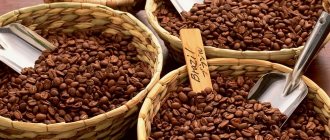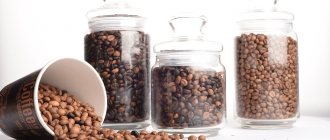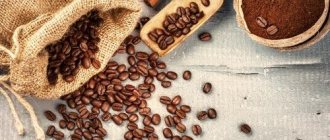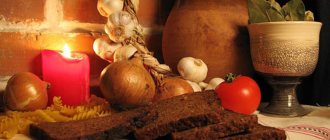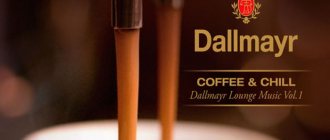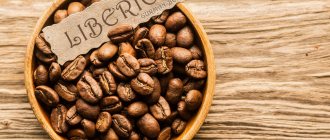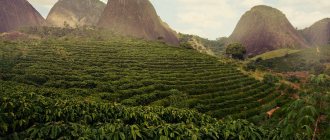Coffee from the Dominican Republic: interesting facts
It all started back in the 18th century, when Spanish colonists brought seedlings of coffee trees to the island from the island of Martinique. Since then, coffee plantations have grown rapidly, and now they can be found in various parts of the Dominican Republic. The most extensive plantations grow in the provinces of Barahona, Azua, Bani, Moca, Barouco, as well as in the Cibao Valley.
On our website you can purchase wonderful excursions in the Dominican Republic!
Book excursions
In the highlands of the country, only the highest grade of Arabica is grown. True coffee lovers know that Dominican coffee is considered one of the best in the world, and invariably prefer this exquisite drink. All Dominican coffee beans are rich in oils and are also rich in caffeine. There is even a special association in the country, ADOCAFES, which is involved in assessing the taste of coffee, as well as improving new varieties.
Coffee trees of the tipica subspecies, which make up 90% of Dominican coffee, are quite capricious, but at the same time, traditionally have high quality indicators. They are grown at altitudes from 600 to 1450 meters. Due to the diversity of the island's microclimate, coffee is harvested almost all year round in the Dominican Republic. But the most productive months are July and August.
Coffee production technology
Typically, coffee trees reach no more than four meters in height, with each tree producing approximately 4 kilograms of fruit per year. After roasting the beans, 1 kilogram of the finished product is obtained. Coffee trees are magnificent when they are in flower. In addition, flowers exude a subtle, pleasant aroma. As coffee berries ripen, they change color from green to red, and then to dark burgundy. A ripe coffee berry contains 2 coffee beans.
After ripening, the fruits are carefully picked by hand, washed in water, dried, peeled, and then sent to producers. Some farmers pre-roast the grains themselves.
If you are interested in seeing with your own eyes the process of growing and processing coffee, you can go on one of the excursions in the Dominican countryside, the route of which includes a visit to a Dominican ranch. Local residents will take you around their property, showing you how coffee, cocoa, tobacco, mangoes, bananas, pineapples, and many other crops grow.
ON OUR WEBSITE YOU CAN PURCHASE WONDERFUL EXCURSIONS IN THE DOMINICAN CAN, CLICK AND FIND OUT DETAILS!
Coffee culture: Dominican traditions
Absolutely all residents of the Dominican Republic are real coffee lovers. By the way, there is no culture of drinking tea on the island, as such. And you can’t find or buy good tea either. But there is plenty of coffee to suit every taste and budget.
Dominicans themselves drink coffee at any time of the day. It is usually prepared in special geyser coffee makers and then poured into small cups. The coffee is very strong, and locals always generously add sugar to it.
The fact is that Dominicans also have a terrible sweet tooth. Sometimes the drink even resembles coffee syrup. Therefore, when buying a cup of coffee in the Dominican Republic, ask for sugar separately - sin azukar. Also popular in the Dominican Republic is coffee with milk – café con leche.
Popular varieties
Dominicans drink coffee at any time of the day, despite the fact that the drink has a high strength. The grains are rich in essential oils and caffeine.
Each tree produces 4 kg of grains per season. Of these, 1 kg goes on sale , as a careful selection is carried out. Broken, irregularly shaped fruits and small berries are subject to culling.
Roasting is carried out by large factories and small farmers. There are different processing methods - wet and dry. When dry, the grains are kept in air for 10 days, then cleaned and sent for roasting.
Santo Domingo
Monosort Santo Domingo is the most popular among tourists and is considered the best in terms of taste. It is superior to similar varieties of Typica grown in Brazil. You can buy elite coffee in the Dominican Republic very cheaply.
This doesn't mean he's second-rate. Santo Domingo is a local attraction that is sold everywhere - in grain and ground form. It is suitable for making espresso and brewing in a Turkish coffee maker, geyser coffee maker, or French press.
The best Dominican coffee is affordable for every tourist. It is allowed to be taken away in whole packages of 20 packs. Fortunately, such volumes are allowed through at the airport during inspection, because tourism and the coffee industry bring a lot of money to the state treasury.
Interesting! Instant coffee is not brought from the Dominican Republic, because it simply is not there. The main advantage is that these are single-varietal grains, which are worth buying as a gift or purchasing for yourself.
Barahona
Barahona coffee is considered the second most popular in the Dominican Republic. It grows at an altitude of up to 1,300 m. The aroma of tobacco, spices, and prunes is heard in the grains. The acidity of Barahona is low, the taste is rather velvety-piquant. The sophistication of this variety is given by its proximity to walnut trees, in the shade of which trees grow.
You need to choose which coffee to bring from the Dominican Republic while traveling. This is the usual sampling method. You can accidentally discover a new variety that will be remembered for a long time.
Induban
Induban is a variety of Santo Domingo, but at a higher price. The taste is more creamy vanilla than chocolate prune. It will appeal to those people who prefer the sweet aftertaste of a coffee drink.
Important! All trees are grown without the use of chemicals, as the rich soil composition promotes healthy plant immunity
Blasercafe Ocoa
The strongest coffee. It is recommended to buy it in reserve for those who have difficulty waking up in the morning. Even with heavy roasting, a high dose of caffeine remains in the beans. The taste feels spicy and chocolate, there is no sourness.
Video: Which Dominican coffee to choose - review
Cafe Pilon
The variety is created based on the proximity of coffee trees to plants that synthesize large amounts of essential oils. This gives the beans a new taste - citrusy-spicy, without bitterness, with a rose aroma. In addition, it protects plantations from pests and diseases.
Monte Alto
For lovers of coffee acidity, this is not the best coffee in the Dominican Republic, since it is absent from the beans. But Monte Alto is sold already ground and you can choose the degree of roasting and grinding. The variety is not expensive, as it grows below 1,700 m in the mountains.
Green coffee
The stores sell green coffee for adherents of a healthy lifestyle and nutrition. Its advantage is its rich composition of useful organic substances, microelements and chlorogenic acid, which actively breaks down fat in the body. You can recognize the variety by its bright green packaging with a pattern of unroasted beans.
Dominican coffee varieties
Santo Domingo and Induban coffee are the most popular brands
One of the largest coffee producers in the Dominican Republic is the Induban factory. It produces the most popular and most affordable Santo Domingo coffee, as well as the slightly more expensive Induban, which combines Typica and bourbon.
Santo Domingo coffee is sold almost everywhere, both ground and beans. It is best suited for making espresso in a Turk or geyser coffee maker. Despite the low price, this is high quality coffee that has a pleasant taste and rich aroma. As for Induban coffee, it is a drink with a thicker and tart taste.
Monte Real – finely ground coffee
Keep in mind that you are unlikely to find instant coffee in the Dominican Republic. And in general, this is a very dubious drink that has almost nothing in common with real coffee. However, if you are used to preparing coffee in a hurry when you don’t have time to brew it, the Monte Real variety is suitable for you. This coffee is very finely ground, so you can safely simply brew it in a mug with boiling water. But it is better, of course, to cook it according to all the rules - over low heat until it boils. This drink has a mild taste and chocolate aroma.
Barahona and other varieties
It is not only the Santa Domingo variety that keeps the country's coffee industry alive. There are other decent examples of coffee here.
Barahona
The second most popular variety in the Dominican Republic. It is grown at an altitude of 700 to 1300 meters above sea level. The trees are protected by the crowns of their nut and fruit counterparts from the scorching sun. The finished drink has low acidity, a rich chocolate-prune base, savory notes of nuts and spices, warm tones of caramel and tobacco.
Monte Alto
The variety grows relatively low at an altitude of 700-1700 meters. There are two main varieties - Espresso and Premium. The first one has a strong roast and is intended for preparation in automatic coffee machines. The second is more delicate, has a medium roast, and is suitable for manual cooking. The variety is distinguished by a warm flavor range, in which nutty, chocolate and earthy shades are felt, and there is almost no sourness.
Monte Real
Distributed in the Dominican Republic itself. It is sold already in ground form. The grind is very fine, well suited for popular hand-cooking options. The flavor profile of the drink is chocolate and cocoa with notes of prunes and nuts. Like most varieties of Dominican coffee, Monte Rial is distinguished by its strength and high caffeine content.
Green coffee is a drink for those who care about their health and figure
Those who watch their figure and want to lose weight should pay attention to green coffee from the Dominican Republic. This coffee does not have a pronounced taste and aroma, but it is considered very healthy due to its antioxidant properties, as well as the content of chlorogenic acid, which promotes fat burning.
It is believed that green coffee increases mental and physical activity, perfectly tones, and also helps with headaches. In stores it is easily recognized by its bright packaging, which depicts green coffee beans.
How much does coffee cost in the Dominican Republic?
Coffee prices can vary depending on the size of the package and the type of grind. Also, the cost of coffee may vary in different stores. We present the order of prices for different types of coffee in the Dominican Republic:
- Coffee Santo Domingo - 4-9 dollars per package
- Induban Coffee - $8 per pack
- Coffee Monte Real - $7-14 per package
- Coffee Cibao, Barahona, Bani, Okoa, Monte Alto, Café Caribeño - about $15 per package
- Coffee Don Rogerio (Don Rogerio Blend and Arom) - from $16 per package
- Coffee Don Justino - from $16 per package
- Green coffee – 7 – 17 dollars per package
Cereal product
Some fans prefer to buy Santo Domingo coffee beans. This choice can be fully explained. The taste of the finished drink is greatly influenced by the correct grinding of the coffee beans. Even the smallest mistake made during this process can completely ruin the product. And buyers who know a lot about this prefer to do everything themselves.
For them, in Russian stores, Dominican coffee is presented in a fairly wide range:
- Aroma. This medium roast coffee is made from a blend of two types of Arabica: Bourbon and Typica. After brewing, it produces a wonderful aromatic drink with a delicate taste. At the same time, a delicate foam forms on the surface of the cup.
- Caracolillo. This is also a medium roast product, which does not contain a single Robusta grain.
- Puro Cafe. Has the same composition as Aroma. True, in this case a light degree of roasting is used.
- Café Induban Gourment includes the same two types of Arabica. But here a dark degree of roasting is already used.
Each of these products is good in its own way. The buyer can only decide how strong and rich the drink he wants to prepare for himself.
Where to buy Dominican coffee?
In the resort area, in regular stores and even in large supermarkets, only the most popular types of coffee are found: Santo Domingo and Induban. To have a large selection of coffee varieties, it is best to go to special tourist shops. There are quite a lot of them both in the resort area of Punta Cana and in the colonial part of the city of Santo Domingo, the capital of the Dominican Republic.
Sometimes you can buy coffee at the ranch, where you stop on some excursions. But keep in mind that in “home production” no one monitors the quality, and sometimes such coffee has a slightly “burnt” taste.
An excursion into the history of Dominican coffee
Coffee trees are by no means native to the New World: they got there along with the colonialists. In the Dominican Republic, coffee began to be cultivated in the 18th century. At first, its quality left much to be desired, but over time, local planters learned to grow and process coffee, as a result of which the taste of the invigorating drink from the Dominican Republic became beyond praise.
Nowadays, coffee exports bring substantial income to the state treasury. And although Dominicans are very proud of their coffee and drink it at any time of the day with or without reason, the bulk of the beans are exported. Some manufacturers from other countries use a trick: they mix a small amount of ground coffee from the Dominican Republic into their products in order to call their products Dominican. But truly Dominican coffee can only be bought in its homeland. In Russia, you always run the risk of running into a fake.
The most famous brands in the world are Santo Domingo and Barahona. Santo Domingo coffee is one of the three world leaders in taste.
It is named after the capital of the Dominican Republic, however, what is interesting is that there is not a single coffee plantation in its vicinity.
